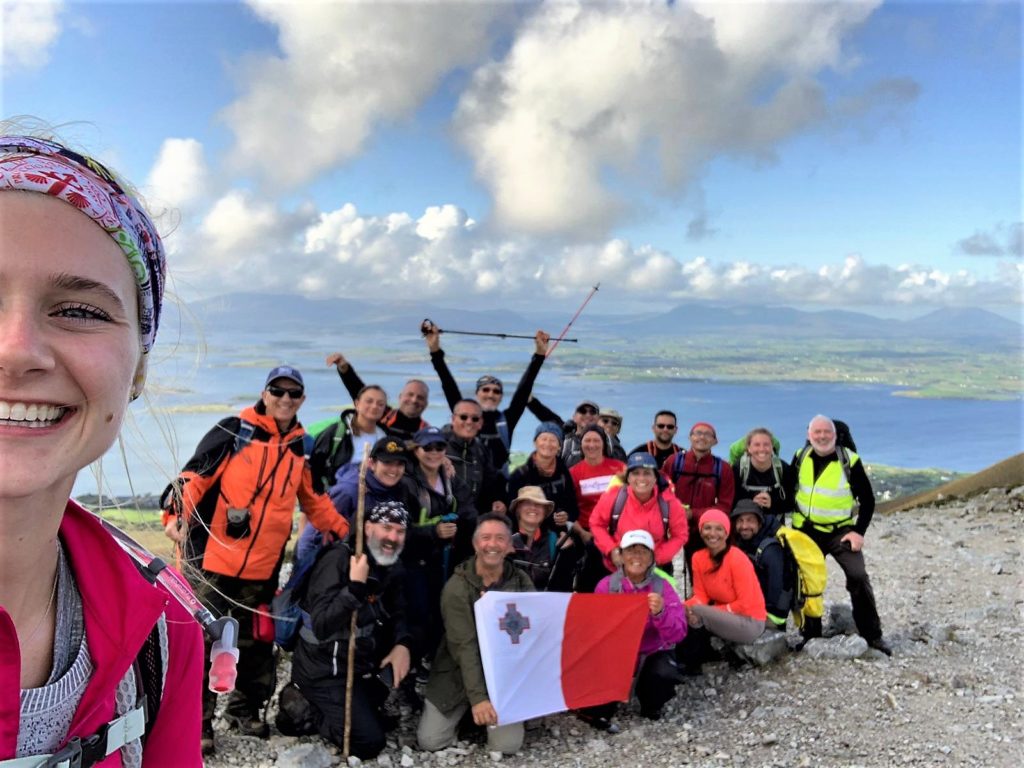
XirCammini walked the Irish Caminos in August 2019 consisting of (a.) St. Kevin’s in County Wicklow, (b.) St. Finbarr’s in County Cork, (c.) Cnoc na dTobar in County Kerry, (d.) Cosán na Naomh in the Dingle Peninsula and (e.) Tóchar Pádraig in County Mayo.
Any one interested to learn more about our treks please drop us an email on information@xircammini.org | or join our community on Facebook : https://www.facebook.com/groups/345359409704852/ | or follow us on our Facebook Page ‘XirCammini’: https://www.facebook.com/XirCammini/?view_public_for=2202460050021157
This is the fifth piece of a five-part series on the Celtic Saints commemorated on the Irish Caminos.
It has been a few weeks since we returned home from Ireland but I still catch myself repeating the words of Fr. Frank Fahey, “Light a candle before you go, include strangers in your group and no complaining.”
To these basic principles we also included “travel light” and “help fellow pilgrims” as 61 Maltese walked the Irish Caminos in August and September, ending with the St. Patrick’s Path from Ballintubber to Croagh Patrick.
The Tóchar Pádraig commences from Ballintubber Abbey, following an ancient road from this seat of the Kings of Connaught and ends in Croagh Padraig in County Mayo. The walk is graded as ‘moderate’ but one is to expect wet underfoot conditions in places in what is arguably a relatively exacting environment. Raingear, trekking boots and warm clothing is generally required. In August County Mayo experiences temperature highs of 16ºC with a 35% to 40% chance of rain.
In pre-Christian times a pagan pilgrimage route preceded Tóchar Pádraig on what used to be a Chariot road.
The route offers historical and natural perspectives with the Abbey, Creevagh Well, Clareen River, Patrick’s Chair, the Aghagower, St.Patrick’s Well, Peter’s Stone, Loch na Corra and more.
Part Five: St. Patrick, Ballintubber and Croagh Padraig [County Mayo]
The name Ballintubber or Ballintober is derived from Baile Tobair Phádraig , meaning the place of St. Patrick’s well. Creevagh well is situated relatively close to the Augustinian Abbey and is said to be where St. Patrick baptized people in their hundreds after he founded his church. Although the walk is typically from Ballintubber Abbey to Croagh Padraig, legend has it that St. Patrick fasted for 40 days on Croagh Padraig and then travelled to where the abbey is today to found his church.
Although St. Patrick founded his church in the mid-5th century AD (i.e. around 150 years before St. Augustine brought Roman Catholicism to the British Isles and founded his church in Canterbury), the current Abbey was founded as an Augustinian Abbey by the King of Connacht in 1216 and has had an 800-year old history through Henry VIII, penal laws, Cromwellian persecution, priest hunters, confiscation of land and revival some 20 years ago.
XirCammini Treks
This trek was truly invigorating physically as well as spiritually. Furthermore, there is nothing that beats exercise in fresh air in the company of friends for our well-being. We started from Ballintubber Abbey undertaking a linear, mostly easy to moderate trail with slight inclines and declines mainly through wet land until reaching Ahagower. From there onwards to Croagh Pádraig we went through fields, road and a Bronze Age site where – later – St. Patrick is said to have preached. Adding the walk from and to town to the hill the overall length would be of around 35 km.
While this year’s XirCammini Irish Caminos are fully subscribed, we look forward to hearing from you if you are interested in joining either XirCammini as a member, another one of our treks this year or the Irish Caminos in 2020. Anyone wishing to join us from overseas, arrangements can be made for us to meet at destination prior to commencing a trek.
XirCammini is a NGO registered as Members’ Association with the Office of the Commissioner for Voluntary Organisations, Malta (VO No: 1646). Contact details:
information@xircammini.org | www.xircammini.org | https://www.facebook.com/groups/345359409704852/